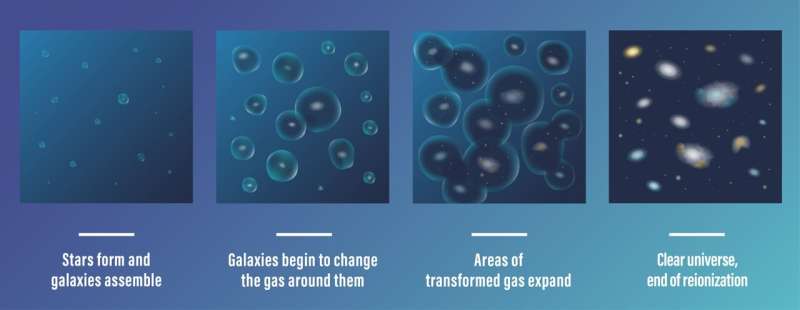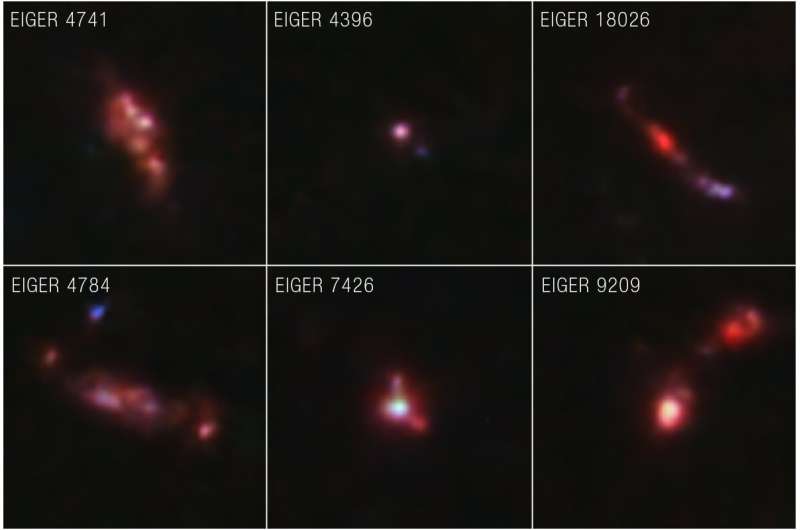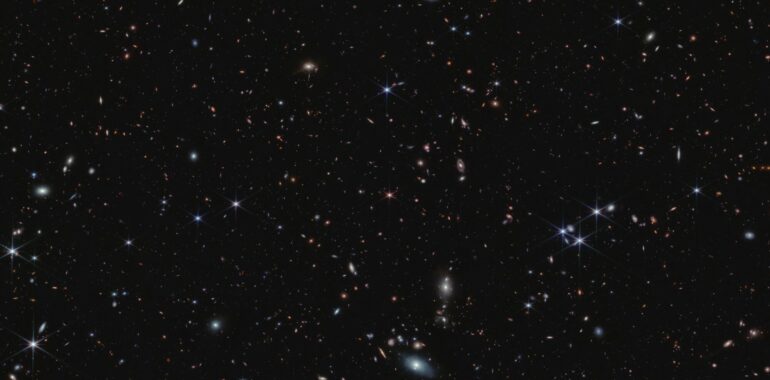In the early universe, the gas between stars and galaxies was opaque—energetic starlight could not penetrate it. But 1 billion years after the big bang, the gas had become completely transparent. Why? New data from NASA’s James Webb Space Telescope has pinpointed the reason: The galaxies’ stars emitted enough light to heat and ionize the gas around them, clearing our collective view over hundreds of millions of years.
The results, from a research team led by Simon Lilly of ETH Zürich in Switzerland, are the newest insights about a time period known as the Era of Reionization, when the universe underwent dramatic changes. After the big bang, gas in the universe was incredibly hot and dense. Over hundreds of millions of years, the gas cooled. Then, the universe hit “repeat.” The gas again became hot and ionized—likely due to the formation of early stars in galaxies, and over millions of years, became transparent.
Researchers have long sought definitive evidence to explain these transformations. The new results effectively pull back the curtain at the end of this reionization period. “Not only does Webb clearly show that these transparent regions are found around galaxies, we’ve also measured how large they are,” explained Daichi Kashino of Nagoya University in Japan, the lead author of the team’s first paper. “With Webb’s data, we are seeing galaxies reionize the gas around them.”
These regions of transparent gas are gigantic compared to the galaxies—imagine a hot air balloon with a pea suspended inside. Webb’s data shows that these relatively tiny galaxies drove reionization, clearing massive regions of space around them. Over the next hundred million years, these transparent “bubbles” continued to grow larger and larger, eventually merging and causing the entire universe to become transparent.
Lilly’s team intentionally targeted a time just before the end of the Era of Reionization, when the universe was not quite clear and not quite opaque—it contained a patchwork of gas in various states. Scientists aimed Webb in the direction of a quasar—an extremely luminous active supermassive black hole that acts like an enormous flashlight—highlighting the gas between the quasar and our telescopes. (Find it at the center of this view: It is tiny and pink with six prominent diffraction spikes.)

More than 13 billion years ago, during the Era of Reionization, the universe was a very different place. The gas between galaxies was largely opaque to energetic light, making it difficult to observe young galaxies. What allowed the universe to become completely ionized, leading to the “clear” conditions detected in much of the universe today? Researchers using NASA’s James Webb Space Telescope found that galaxies are overwhelmingly responsible. © NASA, ESA, CSA, Joyce Kang (STScI)
As the quasar’s light traveled toward us through different patches of gas, it was either absorbed by gas that was opaque or moved freely through transparent gas. The team’s groundbreaking results were only possible by pairing Webb’s data with observations of the central quasar from the W. M. Keck Observatory in Hawaii, and the European Southern Observatory’s Very Large Telescope and the Magellan Telescope at Las Campanas Observatory, both in Chile.
“By illuminating gas along our line of sight, the quasar gives us extensive information about the composition and state of the gas,” explained Anna-Christina Eilers of MIT in Cambridge, Massachusetts, the lead author of another team paper.
The researchers then used Webb to identify galaxies near this line of sight and showed that the galaxies are generally surrounded by transparent regions about 2 million light-years in radius. In other words, Webb witnessed galaxies in the process of clearing the space around them at the end of the Era of Reionization. To put this in perspective, the area these galaxies have cleared is approximately the same distance as the space between our Milky Way galaxy and our nearest neighbor, Andromeda.
Until now, researchers didn’t have this definitive evidence of what caused reionization—before Webb, they weren’t certain precisely what was responsible.
What do these galaxies look like? “They are more chaotic than those in the nearby universe,” explained Jorryt Matthee, also of ETH Zürich and the lead author of the team’s second paper. “Webb shows they were actively forming stars and must have been shooting off many supernovae. They had quite an adventurous youth!”

NASA’s James Webb Space Telescope has returned extraordinarily detailed near-infrared images of galaxies that existed when the universe was only 900 million years old, including never-before-seen structures. These distant galaxies are clumpy, often elongated, and are actively forming stars. © NASA, ESA, CSA, Simon Lilly (ETH Zürich), Daichi Kashino (Nagoya University), Jorryt Matthee (ETH Zürich), Christina Eilers (MIT), Rob Simcoe (MIT), Rongmon Bordoloi (NCSU), Ruari Mackenzie (ETH Zürich); Image Processing: Alyssa Pagan (STScI), Ruari Macke
Along the way, Eilers used Webb’s data to confirm that the black hole in the quasar at the center of this field is the most massive currently known in the early universe, weighing 10 billion times the mass of the Sun. “We still can’t explain how quasars were able to grow so large so early in the history of the universe,” she shared. “That’s another puzzle to solve!” The exquisite images from Webb also revealed no evidence that the light from the quasar had been gravitationally lensed, ensuring that the mass measurements are definitive.
The team will soon dive into research about galaxies in five additional fields, each anchored by a central quasar. Webb’s results from the first field were so overwhelmingly clear that they couldn’t wait to share them. “We expected to identify a few dozen galaxies that existed during the Era of Reionization—but were easily able to pick out 117,” Kashino explained. “Webb has exceeded our expectations.”
Lilly’s research team, the Emission-line galaxies and Intergalactic Gas in the Epoch of Reionization (EIGER), have demonstrated the unique power of combining conventional images from Webb’s NIRCam (Near-Infrared Camera) with data from the same instrument’s wide-field slitless spectroscopy mode, which gives a spectrum of every object in the images—turning Webb into what the team calls a “spectacular spectroscopic redshift machine.”
The team’s first publications include “EIGER I. a large sample of [O iii]-emitting galaxies at 5.3 led by Kashino, “EIGER II. first spectroscopic characterisation of the young stars and ionised gas associated with strong Hβ and [OIII] line-emission in galaxies at z = 5—7 with JWST,” led by Matthee, and “EIGER III. JWST/NIRCam observations of the ultra-luminous high-redshift quasar J0100+2802,” led by Eilers, and will be published in The Astrophysical Journal on June 12.
More information:
Daichi Kashino et al, EIGER. I. A Large Sample of [O iii]-emitting Galaxies at 5.3 The Astrophysical Journal (2023). DOI: 10.3847/1538-4357/acc588
Jorryt Matthee et al, EIGER. II. First Spectroscopic Characterization of the Young Stars and Ionized Gas Associated with Strong Hβ and [O iii] Line Emission in Galaxies at z = 5–7 with JWST, The Astrophysical Journal (2023). DOI: 10.3847/1538-4357/acc846
Anna-Christina Eilers et al, EIGER. III. JWST/NIRCam Observations of the Ultraluminous High-redshift Quasar J0100+2802, The Astrophysical Journal (2023). DOI: 10.3847/1538-4357/acd776
Provided by
NASA’s Goddard Space Flight Center
Citation:
Webb Telescope proves galaxies transformed the early universe (2023, June 13)



